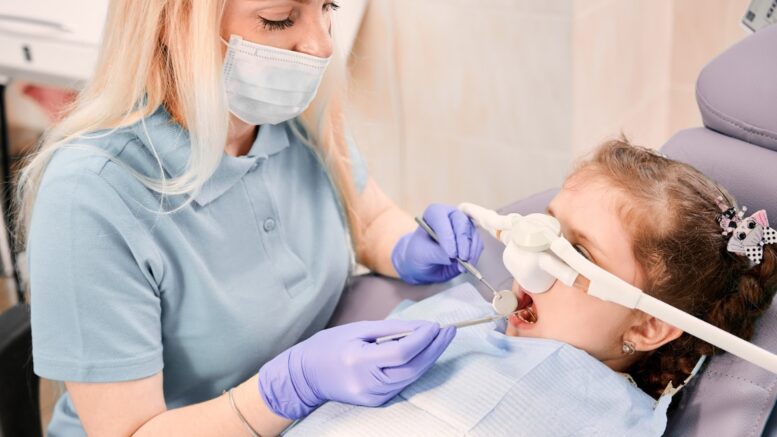Visiting the dentist can be very challenging for kids, mainly if the visit entails invasive steps like tooth extraction. Hence the need for dental sedation, which offers comfort and safety during the procedure. Sedation is beneficial for kids as it aids in reducing anxiety and increasing cooperation during dental treatment, which makes the process smooth and successful for the dentist and the child.
Some medication may be used in the sedation of the child. But the selection will depend on the child’s general health, anxiety level, and dental care and treatment recommendations.
Understanding Dental Sedation For Children
As a parent or guardian, you play an essential role in your child’s dental care. Therefore, it’s best to have more information about dental sedation for kids.
Endorsed by the American Academy of Pediatric Dentistry, dental sedation is used to calm and relax children. Here are the different types:
- Nitrous Oxide: It’s more commonly known as laughing gas. Nitrous oxide is a mild sedative inhaled through a nosepiece or a mask placed over the nose. The calming effect begins after five minutes. The dentist controls and adjusts the amount of nitrous oxide to be taken in. When the treatment is complete, the nitrous oxide is flushed out of the system through oxygen. It’s generally considered suitable for kids as it helps them feel relaxed and remain conscious and be able to communicate with the dentist.
- Oral Sedation: This type of dental sedation is administered in pill or liquid form. It can help the child feel relaxed and drowsy during the procedure. The child can be conscious but in a state of deep relaxation.
- IV Sedation: Intravenous (IV) sedation is a deep level of sedation. It’s usually administered directly to the bloodstream through the vein. With this type of sedation, the child may fall asleep. It can be an ideal option for children with severe dental anxiety or those undergoing lengthy and invasive procedures.
The type of sedation will depend on the patient’s age, anxiety level, pain tolerance, medical recommendations, and the complexity of the dental procedure. You may visit alligatordentist.com for more information on the type of sedation appropriate for your child.
Dental sedation requires appropriate pre- and post-operative care for the well-being and safety of the child.
Pre-Operative Care
Pre-operative care plays a vital role in ensuring safety measures before dental treatment. Observe these guidelines for a successful dental sedation process:
Consult The Dentist
Before scheduling dental sedation and treatment, consult a pediatric dentist experienced in providing sedation for children. The pediatric dentist will need to evaluate the child’s medical and dental history. After conducting a thorough physical examination, the dentist will explain suitable sedation options for your child.
There are different levels of sedation: mild, moderate, and deep sedation. The dentist will recommend the appropriate sedatives and their administration (inhalation, orally, or intravenously) based on the child’s dental state and specific needs.

Management Of Medication
If the child is taking medications, the dentist may give instructions to stop or continue with those medications before the sedation. Some medicines may not interact well with sedation medication, which can lead to complications.
As a parent, you must disclose your child’s allergies, medications, and medical conditions like asthma or diabetes. This ensures that proper precautions can be taken in administering the right and appropriate sedation.
Instructions About Fasting
In most instances, kids scheduled for dental sedation must fast for a given period before the dental procedure. This is crucial in preventing vomiting or aspiration (inhaling liquid or food into the lungs) during sedation. Fasting instructions will depend on the type of sedation to be administered, the child’s age, and their medical condition.
Carefully note down the fasting instructions to be given by the dentist. These will include the specific type of food and drinks to take in and those to avoid, as well as the duration of fasting. It’s essential to strictly follow the fasting instructions for the safety and success of the dental treatment process.
Comfortable Clothing
There’s a need for the child to be comfortably dressed during the dental procedure. You should avoid dressing them in tight-fitting clothes as these may cause discomfort and interfere with the dental process. Belts, jewelry, and other accessories should be avoided as well.
Dress your child in breathable, loose-fitting clothing like pajamas. Bringing something that gives them comfort, like a stuffed animal or favorite blanket, also helps.
Communication And Signing Consent Forms
As a parent, you need to provide informed consent regarding dental sedation. It’s best to communicate freely and openly so that the dental team can consider an alternative if there are any risks.
Before signing the necessary consent forms, ensure all your questions and concerns have been addressed accordingly. The signing of consent forms also entails giving details about the payment method or if you have dental insurance coverage.
In addition, you’re required to provide emergency contact details. You should read and understand the consent form before signing.
Post-Operative Care
Post-operative care is critical to ensure the child recovers well from the dental procedure. Here are essential aspects of post-operative care:
Recovery And Observation
Your child will be taken to the recovery room after the procedure to be monitored until fully awake. The dentist will assess the child before discharging them. Children who have undergone dental sedation usually need one to two hours of recovery time before being discharged.
During the drive home, ensure your child is secure in the vehicle. It’s advisable to have another adult keep an eye on your child if you’re driving. Upon reaching home, keep the child away from potentially dangerous objects or areas, as they may feel drowsy, confused, and clumsy after the procedure.
If the child wants to sleep, position them with their head supported and chin up. Consider waking up the child every hour to drink water to avoid dehydration.
Furthermore, observe the following while your child is recovering:
- Prescribed Diet: Depending on the invasiveness of the procedure and the type of dental treatment, the child can eat and drink after the dental procedure. However, it would be best for the child to wait for the numbness to wear off. The child may start with light and clear drinks, then progress to smoothies and other soft foods. The dentist usually gives specific instructions on which foods to eat and which to avoid.
- Nausea And Vomiting: These are rare side effects of sedatives. When the child feels nauseated, it’s ideal to have them lie down with their head elevated about one foot higher than their feet. If the child vomits, help them get up and turn their head to the side to prevent them from inhaling vomit into their airway. Taking small sips of fluids can help settle the stomach. But if vomiting persists, contact the dentist immediately.
- Enough Rest: The child should get adequate rest after the dental sedation procedure. If the child attends school, it’s advisable for them to stay home for a few days. Children may accidentally hurt themselves while playing. So, it’s essential to let them fully recover from the treatment before resuming normal activities.
- Pain Management: Generally, children experience more intense post-operative pain than adults. Give the pain medication prescribed by the dentist for about two days at regular intervals of four to six hours. The pain will usually subside by the third day.
Careful monitoring of the child is crucial to avoid complications and ensure a speedy recovery.

Follow-up Appointment
A follow-up appointment with the dentist is typically scheduled five to seven days after the procedure. This is critical in checking how well your child is healing. This follow-up visit also allows you to raise any concerns you may have about the treatment’s outcome.
Benefits Of Pre- And Post-Operative Care
Knowing the benefits of pre- and post-operative care can help you apply the necessary steps to ensure a successful dental procedure and promote your child’s dental health.
- Pre-operative care is crucial because it helps prepare for a successful dental procedure. Providing essential details about the dental treatment and process is a significant part of pre-operative care.
- Post-operative care is equally important in enhancing the child’s quick recovery, pain management, monitoring for infections and complications that may occur after the dental treatment, and reducing the scope of sedation side effects that the child may experience.
Conclusion
Dental sedation is beneficial, especially for kids, as it provides relaxation, comfort, and cooperation. In many instances, kids may not cooperate due to the pain they experience. This is where dental sedation can help.
Like any medical procedure, dental procedures for children require thorough pre- and post-operative care to ensure the child recovers quickly. Pre-operative guidelines help you understand what to expect and what is required of you as a parent to ensure the most favorable results of your child’s dental treatment. Post-operative guidelines are likewise critical in ensuring your child’s full and swift recovery. Incorporating these two aspects is vital for enhancing your child’s dental health and overall well-being.
